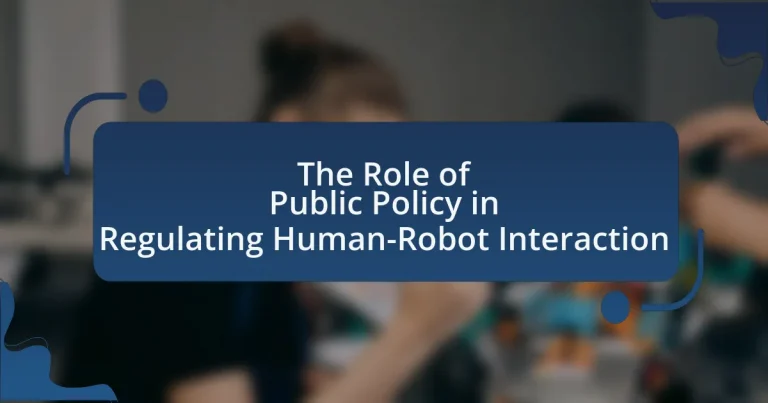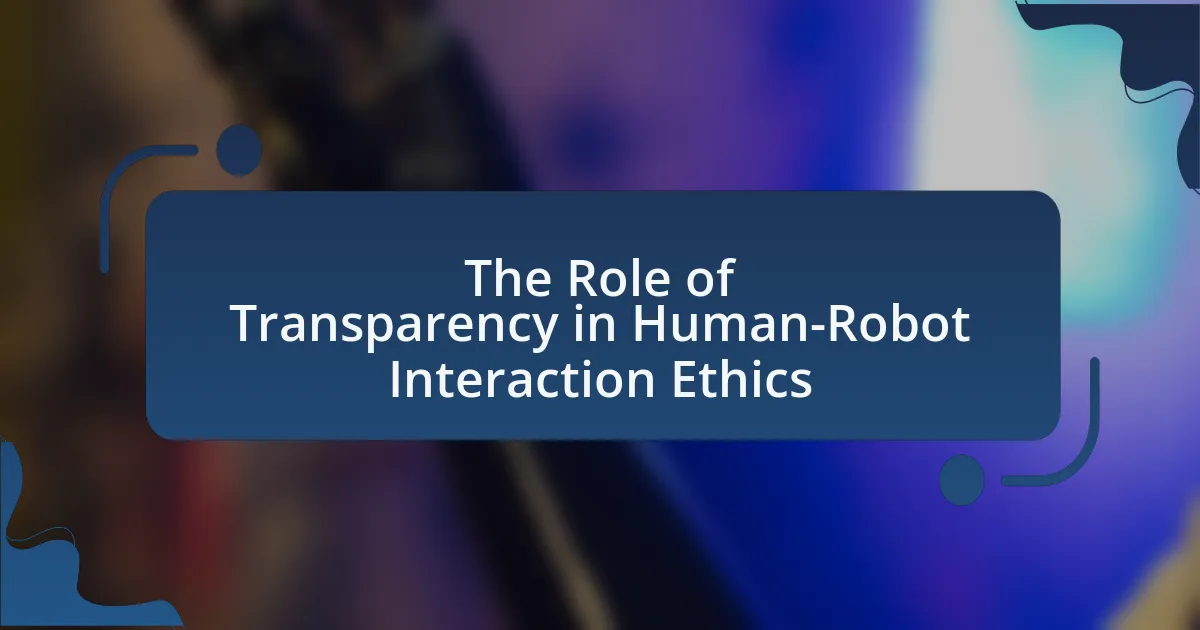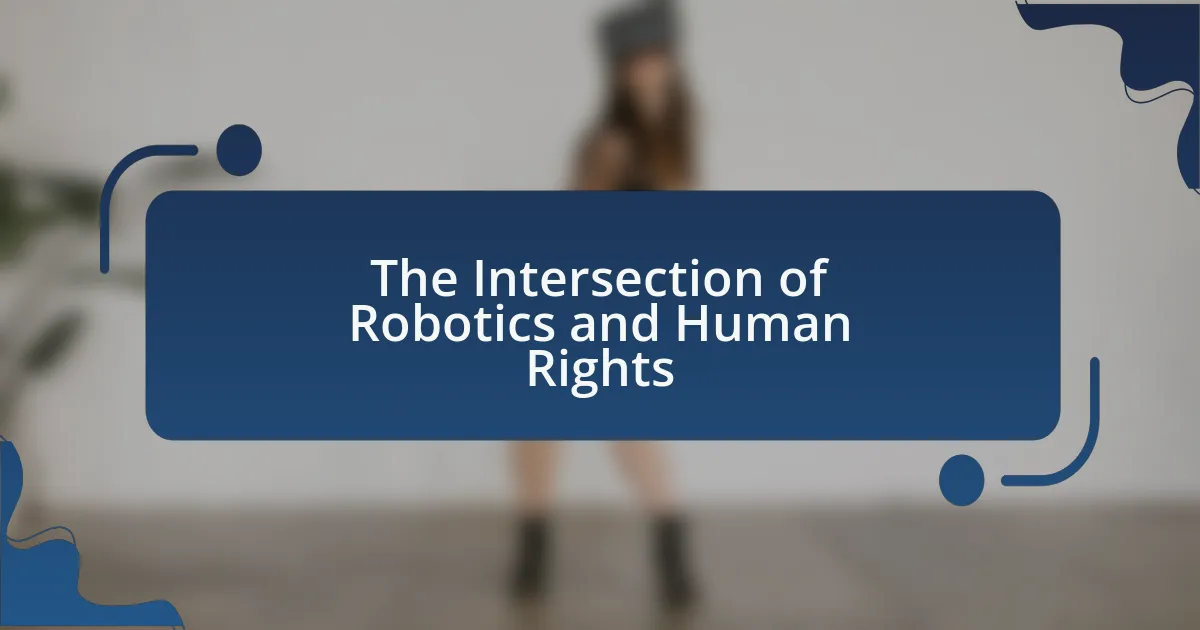The main entity of the article is public policy and its role in regulating human-robot interaction. The article outlines how public policy establishes guidelines and frameworks to ensure safety, ethical standards, and accountability in robotic technologies. It discusses the influence of regulations, such as the European Union’s General Data Protection Regulation (GDPR), on the development and deployment of robots, addressing concerns related to privacy, security, and bias. Key components of effective public policy include regulatory frameworks, ethical guidelines, stakeholder engagement, and enforcement mechanisms, all of which interact with technological advancements to shape responsible human-robot interactions. The article also highlights the challenges policymakers face in keeping regulations relevant amid rapid technological changes and emphasizes the importance of inclusive stakeholder engagement and continuous monitoring for effective policy adaptation.

What is the Role of Public Policy in Regulating Human-Robot Interaction?
Public policy plays a crucial role in regulating human-robot interaction by establishing guidelines and frameworks that ensure safety, ethical standards, and accountability in the deployment of robotic technologies. These policies address concerns such as privacy, security, and the potential for bias in automated systems, thereby fostering public trust and acceptance. For instance, the European Union’s General Data Protection Regulation (GDPR) includes provisions that impact how robots collect and process personal data, highlighting the importance of regulatory measures in shaping responsible human-robot interactions.
How does public policy influence the development of human-robot interaction?
Public policy significantly influences the development of human-robot interaction by establishing regulatory frameworks that govern the design, deployment, and ethical considerations of robotic systems. These policies can dictate safety standards, data privacy regulations, and liability issues, which directly affect how robots are integrated into society. For instance, the European Union’s General Data Protection Regulation (GDPR) sets strict guidelines on data handling, impacting how robots collect and process personal information. Additionally, public policy can promote research and development funding for human-robot interaction technologies, as seen in initiatives like the National Robotics Initiative in the United States, which aims to advance robotics through federal support. Such policies shape the landscape of human-robot interaction by ensuring that technological advancements align with societal values and safety requirements.
What are the key components of public policy in this context?
The key components of public policy in the context of regulating human-robot interaction include regulatory frameworks, ethical guidelines, stakeholder engagement, and enforcement mechanisms. Regulatory frameworks establish the legal parameters within which human-robot interactions occur, ensuring safety and accountability. Ethical guidelines address moral considerations, such as privacy and autonomy, guiding the development and deployment of robotic technologies. Stakeholder engagement involves collaboration among government entities, industry leaders, and the public to create policies that reflect diverse perspectives and needs. Enforcement mechanisms ensure compliance with established regulations and guidelines, providing a means to address violations and adapt policies as technology evolves. These components collectively aim to create a balanced approach that fosters innovation while protecting societal interests.
How do these components interact with technological advancements?
Public policy components interact with technological advancements in human-robot interaction by establishing regulatory frameworks that guide the development and deployment of robotic technologies. These policies ensure safety, ethical standards, and public trust, which are crucial for the acceptance of robots in various sectors. For instance, the European Union’s General Data Protection Regulation (GDPR) sets guidelines for data privacy that affect how robots collect and process personal information, thereby influencing technological design and functionality. Additionally, policies that promote research funding can accelerate innovation in robotics, as seen in initiatives like the National Robotics Initiative in the United States, which aims to advance collaborative robotics. Thus, the interaction between public policy and technological advancements shapes the landscape of human-robot interaction by balancing innovation with societal values and safety concerns.
Why is regulating human-robot interaction important?
Regulating human-robot interaction is important to ensure safety, ethical standards, and societal acceptance of robotic technologies. As robots increasingly integrate into daily life, they pose potential risks such as physical harm to humans, privacy violations, and ethical dilemmas regarding decision-making. For instance, the European Union’s General Data Protection Regulation (GDPR) emphasizes the need for data protection and privacy in automated systems, highlighting the necessity of regulations to safeguard individuals. Furthermore, studies indicate that clear guidelines can enhance public trust in robots, which is crucial for their widespread adoption and effective collaboration in various sectors, including healthcare and manufacturing.
What ethical considerations arise in human-robot interactions?
Ethical considerations in human-robot interactions include issues of autonomy, privacy, accountability, and the potential for bias. Autonomy concerns arise when robots make decisions that affect human lives, raising questions about the extent to which humans should relinquish control. Privacy issues emerge as robots often collect and process personal data, necessitating safeguards to protect individual information. Accountability becomes critical when robots cause harm or make errors, leading to debates about who is responsible—the manufacturer, programmer, or user. Additionally, bias can occur in algorithms, resulting in unfair treatment of certain groups, which highlights the need for ethical guidelines in robot design and deployment. These considerations are essential for developing effective public policy that governs the integration of robots into society.
How can regulation mitigate potential risks associated with robots?
Regulation can mitigate potential risks associated with robots by establishing safety standards, ensuring accountability, and promoting ethical use. Safety standards, such as those set by organizations like the International Organization for Standardization (ISO), provide guidelines that manufacturers must follow to minimize hazards. Accountability measures, including liability laws, ensure that manufacturers and operators are responsible for any harm caused by robotic systems. Furthermore, regulations can promote ethical considerations, such as privacy protection and bias reduction, by requiring transparency in algorithms and decision-making processes. These regulatory frameworks help create a safer environment for human-robot interaction, as evidenced by the implementation of the European Union’s General Data Protection Regulation (GDPR), which addresses data privacy concerns in automated systems.
What challenges do policymakers face in regulating human-robot interaction?
Policymakers face significant challenges in regulating human-robot interaction due to the rapid pace of technological advancement and the complexity of ethical considerations. The swift evolution of robotics and artificial intelligence often outpaces existing regulatory frameworks, making it difficult for policymakers to create relevant and effective laws. Additionally, ethical dilemmas arise regarding privacy, accountability, and the potential for bias in robotic systems, complicating the regulatory landscape. For instance, a study by the European Commission highlights that 70% of citizens express concerns about privacy in relation to AI technologies, indicating a public demand for robust regulatory measures. Furthermore, the lack of standardized definitions and classifications for robots and their functions creates ambiguity in regulation, hindering policymakers’ ability to enforce consistent guidelines.
How do rapid technological changes impact policy formulation?
Rapid technological changes significantly influence policy formulation by necessitating adaptive regulatory frameworks that address emerging challenges and opportunities. As technologies evolve, such as artificial intelligence and robotics, policymakers must respond to new ethical, safety, and economic implications. For instance, the introduction of autonomous vehicles has prompted governments to reconsider traffic laws and liability issues, demonstrating the need for timely updates to existing regulations. Additionally, research from the Pew Research Center indicates that 70% of experts believe that technology will outpace the ability of policymakers to regulate it effectively, highlighting the urgency for proactive policy development in response to rapid advancements.
What are the limitations of existing regulations?
Existing regulations on human-robot interaction are limited by their inability to keep pace with rapid technological advancements. Current frameworks often lack specificity regarding the ethical implications of autonomous systems, leading to gaps in accountability and safety standards. For instance, the European Union’s General Data Protection Regulation (GDPR) does not adequately address the unique challenges posed by AI and robotics, such as data ownership and algorithmic bias. Additionally, many regulations are reactive rather than proactive, resulting in outdated policies that fail to address emerging risks associated with new technologies. This misalignment between regulation and innovation can hinder effective governance and public trust in robotic systems.
How can public policy adapt to evolving human-robot interactions?
Public policy can adapt to evolving human-robot interactions by establishing regulatory frameworks that address safety, ethical considerations, and technological advancements. These frameworks should include guidelines for the design, deployment, and use of robots in various sectors, ensuring they operate safely alongside humans. For instance, the European Union’s General Data Protection Regulation (GDPR) provides a precedent for addressing privacy concerns related to robotic data collection, demonstrating how existing laws can be adapted to new technologies. Additionally, public policy can incorporate stakeholder input, including industry experts and the public, to create comprehensive regulations that reflect societal values and technological realities. This approach ensures that policies remain relevant and effective as human-robot interactions continue to evolve.
What role do stakeholders play in shaping effective policies?
Stakeholders play a crucial role in shaping effective policies by providing diverse perspectives, expertise, and resources that inform decision-making processes. Their involvement ensures that policies are responsive to the needs and concerns of various groups, including industry representatives, community members, and advocacy organizations. For instance, in the context of regulating human-robot interaction, stakeholders such as technology developers, ethicists, and users contribute insights that help identify potential risks and benefits, leading to more comprehensive and balanced regulations. Research indicates that inclusive stakeholder engagement can enhance policy legitimacy and effectiveness, as seen in the development of guidelines for autonomous systems by organizations like the IEEE and ISO, which incorporate input from a wide range of experts and affected parties.
How can public engagement improve policy outcomes?
Public engagement can improve policy outcomes by ensuring that diverse perspectives and needs are considered in the decision-making process. When policymakers actively involve the public, they gain valuable insights that can lead to more effective and relevant policies. For instance, research by the National Academy of Sciences indicates that public participation in policy development can enhance trust in government and increase the likelihood of successful implementation. Engaging citizens allows for the identification of potential issues early on, fostering collaboration and innovation, which ultimately results in policies that better reflect the community’s values and priorities.
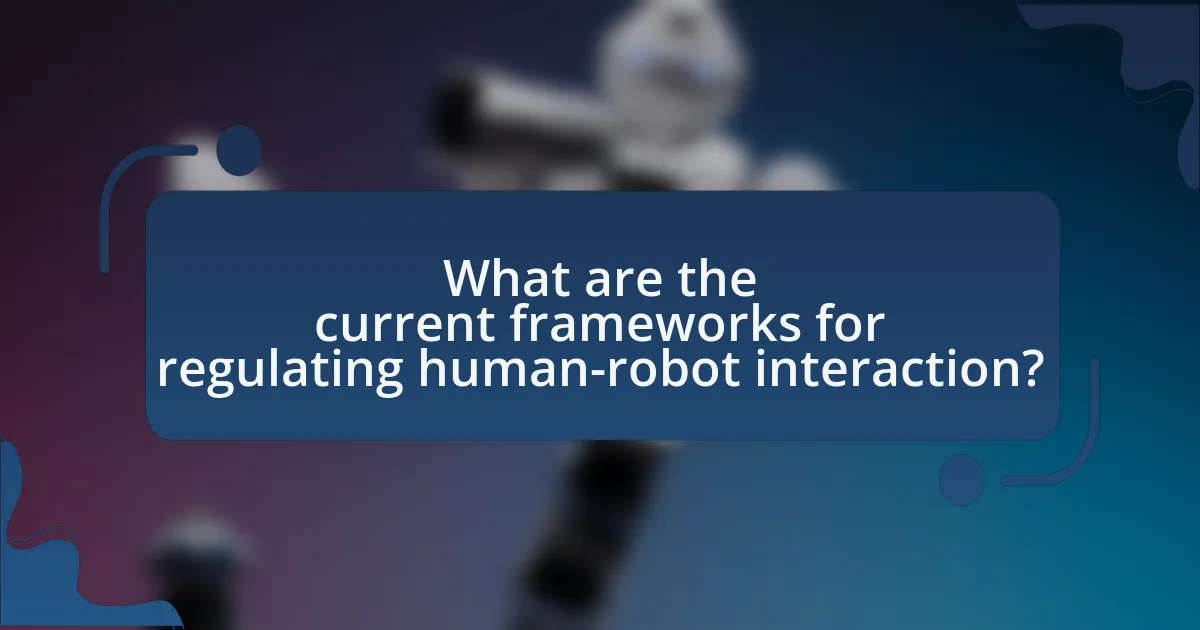
What are the current frameworks for regulating human-robot interaction?
The current frameworks for regulating human-robot interaction include guidelines established by organizations such as the IEEE, ISO, and various national governments. The IEEE’s P7000 series focuses on ethical considerations in autonomous and intelligent systems, while ISO/IEC 20229 provides standards for the safety and performance of robots. Additionally, the European Union’s General Data Protection Regulation (GDPR) impacts how robots handle personal data, emphasizing privacy and data protection. These frameworks aim to ensure safety, ethical use, and accountability in human-robot interactions, reflecting the growing integration of robots in society.
What existing laws and regulations govern human-robot interaction?
Existing laws and regulations governing human-robot interaction include the European Union’s General Data Protection Regulation (GDPR), which addresses data privacy and protection in automated systems, and the U.S. National Institute of Standards and Technology (NIST) guidelines, which provide frameworks for the safe integration of robotics in various sectors. Additionally, the IEEE Global Initiative on Ethics of Autonomous and Intelligent Systems outlines ethical considerations and standards for robot design and deployment. These regulations aim to ensure safety, privacy, and ethical use of robots in society, reflecting the growing need for structured governance in this rapidly evolving field.
How do these laws vary across different countries?
Laws regulating human-robot interaction vary significantly across countries due to differing cultural, ethical, and legal frameworks. For instance, Japan has embraced robotics in everyday life, leading to policies that encourage integration and innovation, while the European Union emphasizes strict regulations focusing on safety and ethical considerations, as seen in the General Data Protection Regulation (GDPR) and proposed AI regulations. In contrast, the United States has a more fragmented approach, with regulations varying by state and industry, reflecting a balance between innovation and public safety. These differences highlight how national priorities and societal values shape the legal landscape surrounding human-robot interaction.
What are the implications of these regulations for developers?
The implications of these regulations for developers include increased compliance costs and the necessity for enhanced safety measures in robot design. Developers must invest in understanding and integrating regulatory requirements into their product development processes, which may lead to longer development cycles and potential delays in bringing products to market. For instance, regulations may mandate specific safety standards, requiring developers to conduct rigorous testing and validation of their robots to ensure they meet these standards. This can result in additional financial burdens, as developers may need to hire specialized personnel or invest in new technologies to comply with the regulations. Furthermore, failure to adhere to these regulations can lead to legal repercussions, including fines or product recalls, emphasizing the importance of regulatory compliance in the development of human-robot interaction technologies.
How effective are current regulatory frameworks?
Current regulatory frameworks are moderately effective in addressing the complexities of human-robot interaction. While some regulations exist to ensure safety and ethical considerations, they often lag behind rapid technological advancements. For instance, the European Union’s General Data Protection Regulation (GDPR) provides a framework for data protection that indirectly impacts robotic systems, yet specific guidelines for robots remain underdeveloped. Additionally, a 2021 report by the IEEE Global Initiative on Ethics of Autonomous and Intelligent Systems highlights that many countries lack comprehensive policies tailored to the unique challenges posed by robotics, indicating a significant gap in regulatory effectiveness.
What metrics can be used to assess their effectiveness?
Metrics that can be used to assess the effectiveness of public policy in regulating human-robot interaction include user satisfaction, compliance rates, safety incident reports, and economic impact assessments. User satisfaction can be measured through surveys and feedback mechanisms, indicating how well policies meet the needs of individuals interacting with robots. Compliance rates reflect the extent to which organizations adhere to regulations, which can be quantified through audits and inspections. Safety incident reports provide data on accidents or malfunctions involving robots, helping to evaluate the effectiveness of safety regulations. Economic impact assessments analyze the financial implications of policies, including job creation or loss, productivity changes, and overall economic growth related to human-robot interactions. These metrics collectively provide a comprehensive view of policy effectiveness in this emerging field.
How do stakeholders perceive the effectiveness of these frameworks?
Stakeholders perceive the effectiveness of frameworks regulating human-robot interaction as generally positive, emphasizing their role in ensuring safety and ethical standards. For instance, research conducted by the European Commission in 2021 highlighted that 78% of stakeholders believe that regulatory frameworks enhance public trust in robotic technologies. Additionally, stakeholders appreciate that these frameworks provide clear guidelines for developers and users, which facilitates innovation while addressing potential risks. This perception is supported by case studies showing that well-defined regulations lead to reduced incidents and increased user satisfaction in environments where robots are deployed.
What future trends might influence public policy in this area?
Future trends that might influence public policy in regulating human-robot interaction include advancements in artificial intelligence, increased public awareness of ethical implications, and the growing demand for transparency in automated systems. As artificial intelligence technology evolves, policymakers will need to address issues related to safety, accountability, and the potential for bias in decision-making processes. Public awareness campaigns highlighting ethical concerns, such as privacy and job displacement, will likely push for regulations that protect citizens’ rights. Additionally, the demand for transparency in how robots operate and make decisions will drive policies that require clear guidelines and standards for robot behavior, ensuring that human users can trust and understand these systems.
How will advancements in AI impact regulatory needs?
Advancements in AI will significantly increase regulatory needs due to the complexities and ethical considerations introduced by autonomous systems. As AI technologies evolve, they present new challenges in areas such as data privacy, accountability, and safety, necessitating updated frameworks to address these issues. For instance, the European Union’s proposed AI Act aims to establish a comprehensive regulatory framework that categorizes AI systems based on risk levels, reflecting the need for tailored regulations. This approach underscores the importance of adapting existing laws to ensure that AI deployment aligns with societal values and public safety.
What emerging technologies should policymakers be aware of?
Policymakers should be aware of artificial intelligence, robotics, and blockchain technology as emerging technologies. Artificial intelligence is transforming industries by enabling automation and data analysis, which can lead to significant economic shifts. Robotics is increasingly being integrated into various sectors, including healthcare and manufacturing, raising questions about labor displacement and safety regulations. Blockchain technology offers secure and transparent transaction methods, which can impact financial systems and data privacy. These technologies are rapidly evolving, necessitating proactive regulatory frameworks to address ethical, legal, and social implications.
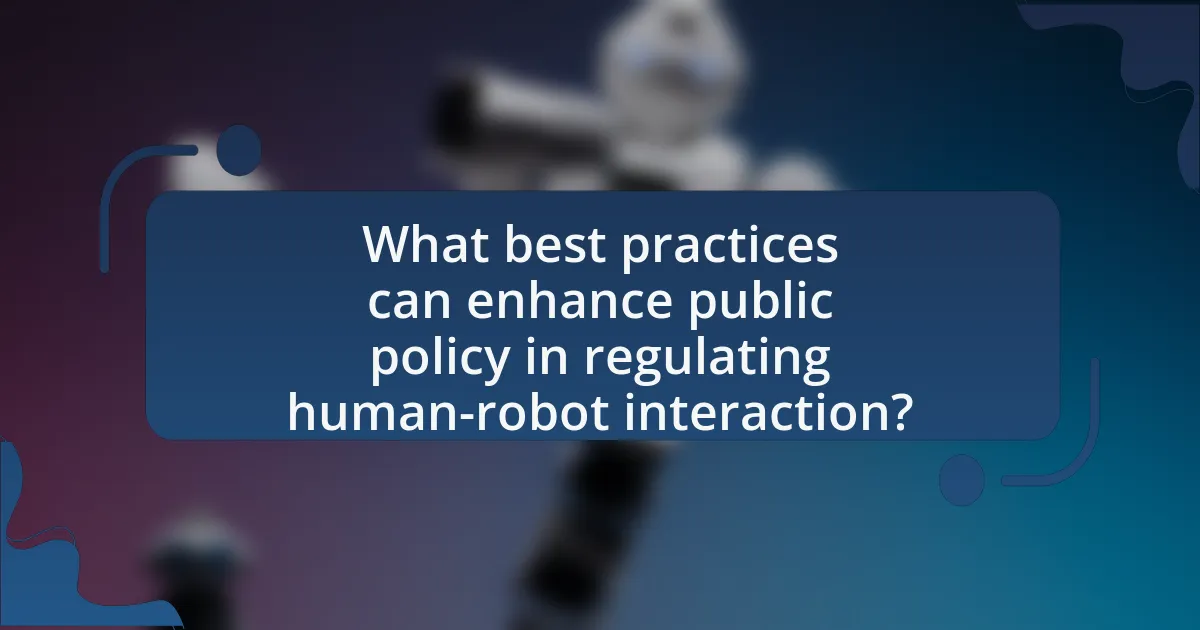
What best practices can enhance public policy in regulating human-robot interaction?
Best practices that can enhance public policy in regulating human-robot interaction include establishing clear ethical guidelines, promoting transparency in robotic systems, and fostering public engagement in policy development. Clear ethical guidelines ensure that human rights and safety are prioritized in the design and deployment of robots, as evidenced by the IEEE Global Initiative on Ethics of Autonomous and Intelligent Systems, which provides a framework for ethical considerations. Transparency in robotic systems, such as disclosing algorithms and decision-making processes, builds trust and accountability, supported by studies indicating that users are more likely to accept robots when they understand their functions. Lastly, fostering public engagement allows diverse stakeholder perspectives to shape policies, as demonstrated by successful initiatives in countries like Japan, where public forums have informed robotics legislation.
How can policymakers ensure inclusive stakeholder engagement?
Policymakers can ensure inclusive stakeholder engagement by implementing structured consultation processes that actively involve diverse groups in decision-making. This approach includes conducting outreach to underrepresented communities, utilizing surveys and public forums to gather input, and ensuring transparency in how stakeholder feedback influences policy outcomes. Research indicates that inclusive engagement leads to more effective policies, as seen in the 2018 study by the National Academy of Sciences, which found that diverse stakeholder involvement enhances the legitimacy and acceptance of public policies.
What methods can be used to gather diverse perspectives?
To gather diverse perspectives, methods such as focus groups, surveys, interviews, and participatory workshops can be employed. Focus groups allow for in-depth discussions among varied participants, facilitating the exchange of different viewpoints. Surveys can reach a broader audience, collecting quantitative data on opinions and experiences. Interviews provide a platform for individual narratives, capturing unique insights. Participatory workshops engage stakeholders in collaborative activities, fostering dialogue and co-creation of ideas. These methods are effective in ensuring that multiple viewpoints are considered, which is crucial in the context of public policy regulating human-robot interaction.
How can feedback mechanisms be effectively implemented?
Feedback mechanisms can be effectively implemented by establishing clear communication channels between users and systems, ensuring that feedback is timely, relevant, and actionable. Research indicates that structured feedback loops, such as surveys and real-time data analytics, enhance user engagement and system responsiveness. For instance, a study by Lee et al. (2020) in the Journal of Human-Robot Interaction highlights that incorporating user feedback into robotic systems significantly improves user satisfaction and operational efficiency. This demonstrates that effective feedback mechanisms not only facilitate better human-robot interaction but also align robotic functionalities with user needs.
What strategies can improve the adaptability of regulations?
To improve the adaptability of regulations, policymakers can implement iterative review processes that allow for regular updates based on technological advancements and societal changes. This approach ensures that regulations remain relevant and effective in the context of rapidly evolving fields such as human-robot interaction. For instance, the European Union’s General Data Protection Regulation (GDPR) includes provisions for periodic assessments, which enable adjustments to be made in response to new challenges and innovations in data privacy. Such strategies foster a dynamic regulatory environment that can better accommodate emerging technologies and their implications.
How can continuous monitoring and evaluation be integrated into policy frameworks?
Continuous monitoring and evaluation can be integrated into policy frameworks by establishing systematic feedback mechanisms that assess policy effectiveness and adapt to emerging challenges. This integration involves creating clear indicators for success, utilizing data collection methods such as surveys and performance metrics, and ensuring stakeholder engagement throughout the evaluation process. For instance, the implementation of adaptive management practices in environmental policy has demonstrated that ongoing assessments can lead to more responsive and effective regulations. By embedding these practices into the policy lifecycle, frameworks can remain relevant and effective in addressing the dynamic nature of human-robot interaction.
What role does international collaboration play in policy development?
International collaboration plays a crucial role in policy development by facilitating the sharing of best practices, resources, and expertise among nations. This collaboration enables countries to address complex global challenges, such as regulating human-robot interaction, through harmonized standards and frameworks. For instance, the International Organization for Standardization (ISO) has established guidelines that promote safety and interoperability in robotics, demonstrating how collaborative efforts can lead to effective policy outcomes. Such cooperation not only enhances the quality of policies but also ensures that they are adaptable to diverse cultural and technological contexts, ultimately fostering innovation and public trust in emerging technologies.
What practical steps can organizations take to comply with regulations?
Organizations can comply with regulations by implementing a comprehensive compliance program that includes regular training, risk assessments, and policy updates. This program should involve educating employees about relevant laws and regulations, conducting periodic evaluations to identify compliance risks, and updating internal policies to reflect changes in legislation. For instance, a study by the Compliance and Ethics Institute found that organizations with structured compliance programs are 50% less likely to face regulatory penalties.
How can companies stay informed about regulatory changes?
Companies can stay informed about regulatory changes by subscribing to industry newsletters, attending relevant conferences, and engaging with regulatory bodies. These actions enable companies to receive timely updates on new laws and regulations that impact their operations. For instance, organizations like the International Association for Robotics and Automation provide resources and updates on regulatory developments. Additionally, utilizing compliance management software can help track changes in regulations across different jurisdictions, ensuring that companies remain compliant and informed.
What resources are available for organizations to navigate compliance?
Organizations can utilize various resources to navigate compliance, including regulatory guidelines, industry standards, compliance software, and legal counsel. Regulatory guidelines, such as those provided by government agencies like the Federal Trade Commission or the European Union’s General Data Protection Regulation, offer frameworks for compliance. Industry standards, such as ISO certifications, provide benchmarks for best practices. Compliance software automates tracking and reporting, making adherence easier. Legal counsel ensures organizations understand and implement relevant laws effectively. These resources collectively support organizations in maintaining compliance within the evolving landscape of public policy and human-robot interaction.
